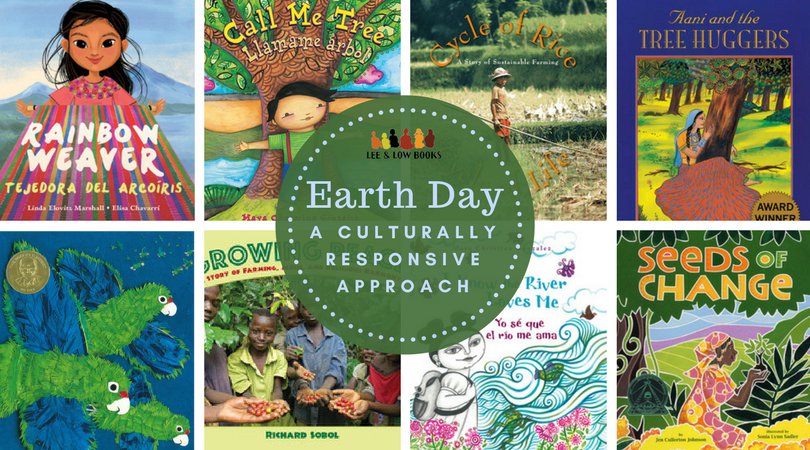
In this ongoing series, we explore what culturally responsive teaching looks like at different grade levels and during holidays and celebrations. In February, we shared a culturally responsive approach to Valentine’s Day. Today, educator Lindsay Barrett offers a culturally responsive approach to Earth Day / Earth Month in the classroom.
People in the United States have celebrated Earth Day on April 22 each year since 1970 to promote environmental awareness, education, and activism. How can culturally responsive teachers make the most of Earth Day discussions in the classroom? Looking at the intersection of the principles of culturally responsive teaching and available research on promoting environmental activism in young people can help provide ideas. Consider exploring these key questions with students:
“In what aspects of the environment are we most interested? How can we learn more?”
You have required subject matter to teach, of course, but many topics related to the environment are well suited to integrated studies that approach a range of standards, so there may be some room for student-driven choices while still targeting your learning goals. (See this list on Edutopia for many Earth Day-themed project-based learning ideas that cover a lot of ground.)
To start, share a read aloud like I Know the River Loves Me/Yo se que el rio me ama by Maya Christina Gonzales, in which a young girl shares  her love and reverence for the river she often visits. Ask students, “What places or aspects of nature make you feel this way?” to encourage them to share their experiences. Or, invite students to share their personal interests in writing. Try reading aloud poems from Francisco X. Alarcon’s Animal Poems of the Iguazu/Animalario del Iguazu, written to express the poet’s appreciation of the wildlife he observed upon visiting the Iguazu Waterfalls. Then ask students to write poems about animals, plants, or other aspects of the environment meaningful to them.
her love and reverence for the river she often visits. Ask students, “What places or aspects of nature make you feel this way?” to encourage them to share their experiences. Or, invite students to share their personal interests in writing. Try reading aloud poems from Francisco X. Alarcon’s Animal Poems of the Iguazu/Animalario del Iguazu, written to express the poet’s appreciation of the wildlife he observed upon visiting the Iguazu Waterfalls. Then ask students to write poems about animals, plants, or other aspects of the environment meaningful to them.
Not surprisingly, research shows that students with a more developed understanding of a topic are increasingly prone to environmental activism, so once you have a better understanding of students’ interests and baseline knowledge, involve them in planning for deeper learning. You can use diverse books like those in this collection to directly share information, or to spark discussion about, “What kinds of information do people need when they’re learning about an environmental topic? How do they get it?”
“What environmental issues are important to our community?”
Nurturing passions about environmental topics that are far removed from students’ own lives can still lead to powerful and productive learning, but an important element of both culturally responsive teaching and research-based practices for encouraging activism in students is to establish connections between students’ learning and their own lives and communities. Share the story of a community’s environmental challenge, like Rainbow Weaver/Tejedora del arcoiris, which portrays a young girl who finds an innovative solution for tackling the problem of plastic bag litter in her Guatemalan village. Facilitate learning about local issues and efforts to protect and improve the environment. Invite students to help plan ways to contribute to community environmental efforts.
 Engagement in actual outdoor experiences is one of the most prevalent influences suggested by research on promoting environmental activism, so when possible, supplement classroom learning with outdoor learning. With younger students, this could be as simple as walking to a nearby tree to make observations after reading and acting out Maya Christina Gonzalez’s Call Me Tree/Llamame arbol. Older students could be involved in planning a visit to a relevant outdoor location in your community. Trish Marx’s Everglades Forever: Restoring America’s Great Wetland provides an example of how students can experience and engage with the environment where they live.
Engagement in actual outdoor experiences is one of the most prevalent influences suggested by research on promoting environmental activism, so when possible, supplement classroom learning with outdoor learning. With younger students, this could be as simple as walking to a nearby tree to make observations after reading and acting out Maya Christina Gonzalez’s Call Me Tree/Llamame arbol. Older students could be involved in planning a visit to a relevant outdoor location in your community. Trish Marx’s Everglades Forever: Restoring America’s Great Wetland provides an example of how students can experience and engage with the environment where they live.
How can people make a difference?
Presenting diverse models of activism can help students begin to construct their own models of how passion, education, and experiences can intersect to propel meaningful change. Biographies of activists are a useful place to start. Seeds of Change, by Jen Cullerton Johnson, tells the inspiring story of Kenyan woman Wangari Maathai’s contributions to the Green Belt Movement. Ask students, “What inspired Wangari?” “What factors contributed to her successful activism?” “What obstacles did she overcome and how?” Compare her story to those of other activists and generate a list of common characteristics.
how?” Compare her story to those of other activists and generate a list of common characteristics.
Literature on factors that promote environmental activism in young people highlights the important influence of collective experiences. Again, diverse books can be a good place to start to learn about collective environmental efforts. For instance, present an in-depth look at a group effort to protect a critically endangered species with Parrots Over Puerto Rico by Susan L. Roth and Cindy Trumbore. Chart how various stakeholders’ contributions combined to achieve successful results. Discuss connections to potential collective actions your students might take now or in the future to support environmental efforts.
By facilitating deeper, student-driven learning, helping students become more involved with key issues in your community, and helping students construct working models of activism, you can increase the impact of Earth Day beyond a one-day celebration. You never know—the experiences you help facilitate for a student in your class could be the ones that fuel a lifelong passion for environmental activism. What better way to save the planet is there than that?
 About the Author: Lindsay Barrett is a former elementary teacher and literacy nonprofit director. She currently works as a literacy consultant and stays busy raising three young boys. Find out more about her work at lindsay-barrett.com.
About the Author: Lindsay Barrett is a former elementary teacher and literacy nonprofit director. She currently works as a literacy consultant and stays busy raising three young boys. Find out more about her work at lindsay-barrett.com.
More in this series:
- What is Culturally Responsive Teaching?
- Culturally Responsive Teaching in Kindergarten: Read Alouds to Build Relationships
- Culturally Responsive Teaching in Grade 1: Intentional Selection of Texts for Reading Discussion
- Culturally Responsive Teaching in Grade 2: Bridging Between the Familiar and Unfamiliar in Literature Discussions
- Culturally Responsive Teaching in Grade 3: Going Beyond the Single Story
- A Culturally Responsive Approach to Discussing Thanksgiving in the Classroom
- How Culturally Responsive is Your Classroom Library?
- Culturally Responsive Approaches to Goal Setting with Students
- Culturally Responsive Teaching: Valentine’s Day








